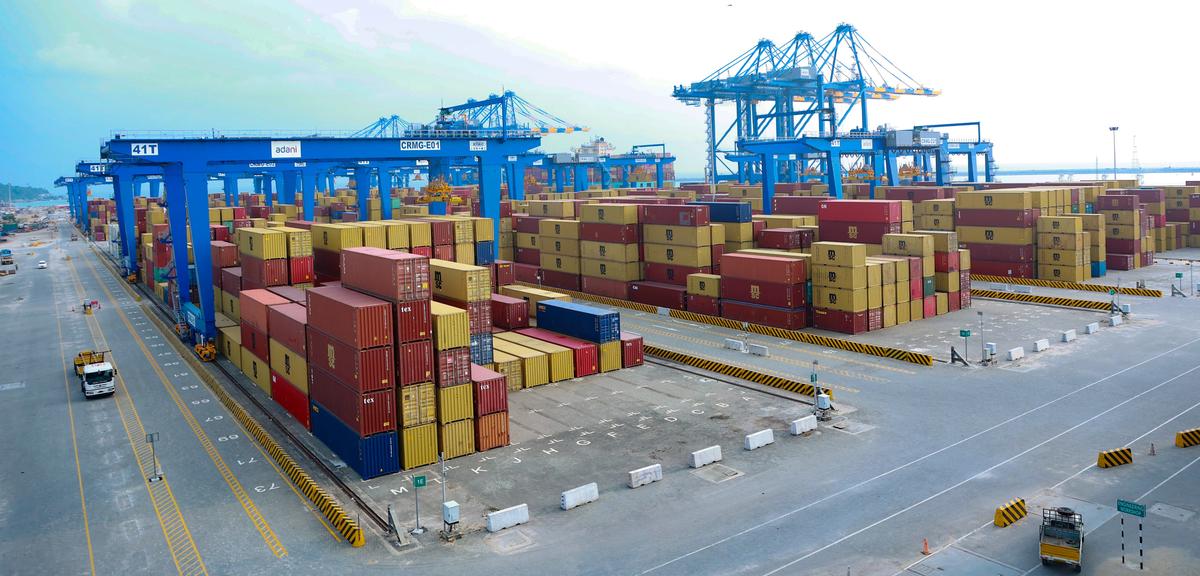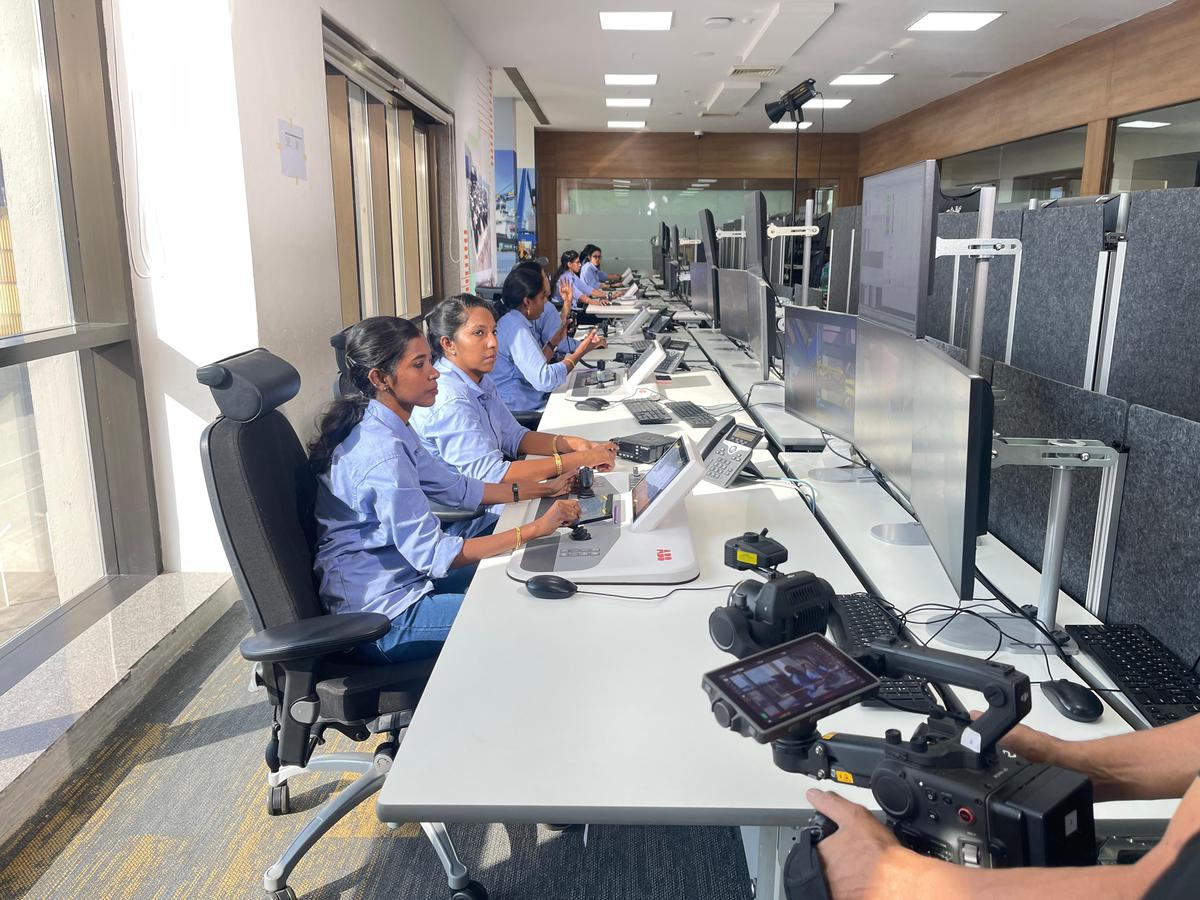As we make our way to the Port Operations Building (POB) inside the expanding Vizhinjam international port in Thiruvananthapuram on a sweltering afternoon, we expect to hear the buzz of vehicles and people moving around. However, near-deafening silence welcomes us. But once we are inside the POB, the scene changes. All the action happens here, in the remote control operations (RCO) room, where a bunch of trained hands monitor, plan and operate the movement of vessels and cargo that leave and arrive at the port.
Among them we see three women, wearing uniforms of pigeon blue shirts and trousers, glued to huge screens, as they monitor the stocking of containers in the yard. They operate CRMG (Cantilever Rail-Mounted Gantry) cranes, which are ‘mounted on rails and move along the dock to lift or transport containers. They are among the nine women CRMG operators who have created history as Vizhinjam port is the only automated port in India and is India’s first international multi-purpose deep water seaport project.
There are 24 CRMG cranes at the port. An operator’s work involves handling the loading and unloading of cargo from the ITV (Internal transit or transportation or transfer vehicle) to the yard and vice versa. The crane is controlled from a remote console. The operator can see the crane’s position, status, and performance on a screen, which displays real-time data and video feeds from the crane’s sensors and cameras. The command is given using a joystick.
Women who operate automated CRMG cranes at Vizhinjam international port in Thiruvananthapuram
| Photo Credit:
Sreejith R Kumar
“The focus has been on skill development and sustainable income generation as per the company’s CSR (Corporate Social Responsibility) and CER (Corporate Environment Responsibility) intervention. We are also committed to the empowerment of women. The objective was to create career opportunities for women, especially those living in the project area, in port-related works, which entails the use of technology,” says an official with the Adani Vizhinjam Port Private Ltd, which is operating the port. The crane operators have been trained at the port under the guidance of Adani Skill Development Centre, which has various port-related courses.

CRMG (Cantilever Rail-Mounted Gantry) cranes at Vizhinjam international port in Thiruvananthapuram
| Photo Credit:
SPECIAL ARRANGEMENT
Applications were invited from degree or diploma holders and the requirement was announced through local resources and institutions. Karthika L, Sreedevi AV, Ashalekshmi P, Anisha S, Prinu P, Steffy Rebeira, Nathana Mary JD, Rejitha RN and Sunitha Raj L are the nine operators, who work with 11 men in the section.
Karthika, 27, is the seniormost, having joined the company before the first batch of cranes arrived at Vizhinjam in October 2023. This diploma holder in instrumentation and engineering has the experience of having operated the RTG (rubber tired gantry) cranes at DP World-run international container trans-shipment project at Vallarpadam in Kochi. “In RTGs, you manually control the crane sitting inside a cabin with the joystick. But CRMG is a different space in terms of the technology and the job profile,” says Karthika.
She underwent a month-long training in Gujarat, where she learned how RMGs lifted containers from trains and also worked in simulated cranes. “I was overjoyed when I got a job at a highly-anticipated project like Vizhinjam port. A memorable moment was when we were allowed to board the first mothership San Fernando when it berthed at the port [on July 11, 2024]. I was there when the first container was lifted. Being the lone woman in that initial batch of seven crane operators it was a privilege,” Karthika says.
(From left) Steffy Rebeira, Karthika L and Anisha S are among the nine women who operate automated cranes at Vizhinjam international port in Thiruvananthapuram.
| Photo Credit:
Sreejith R Kumar
Sreedevi, 37, was the next to join, a month after the trial run of the port started, followed by the others. Nathana, 23, a physics graduate is the youngest.
“All of us had on-the-job training. We now have three 12-hour shifts. Each of us has two day shifts, two night shifts and two days off in that order,” says Anisha S, a post graduate in maths, hailing from Nellikkunnu, who joined the port seven months ago.
Errors can happen, even though the crane can perform most of the movements automatically. Operators intervene in such cases and they manually correct it using joysticks.
Prina, who started work six months ago, says, “The work calls for immense concentration. You can’t afford to take it easy.” A native of Mukkola, this BEd holder, who had been taking tuitions at home, says that she heard about the job from her church. “I have grown up hearing about the project and it feels surreal to be working here. There is job security and workplace safety. Also, it feels great to be making our presence in a male-dominated field. Only that I need to get used to the 12-hour shift,” says the 31-year-old.
At least two vessels berth at the port daily. As per the data released a couple of days ago, the port handled the maximum number of cargo among the 15 ports in the eastern and southern regions of the country last month, which is 78,833 TEUs (Twenty-foot Equivalent Units) from 40 ships, that too eight months after the trial run and three months of commercial operations.

Nine women are among the 20 people who operate automated CRMG cranes at the Vizhinjam international port
| Photo Credit:
SPECIAL ARRANGEMENT
When there are no vessels, the operators get busy with reassembling the containers in the yard. “The containers are rearranged so as to expedite loading,” Karthika says.
Since all these women staff belong to low-income families they cherish the financial independence attained through the job. Most of them are married with kids. Steffy, who joined last September, says, “I was teaching at a private school after my BEd. The work atmosphere and the nature of the job have changed my life for the better,” says Steffy.
Anisha adds, “All that I have to do is commit myself fully to this job. It might look easy, but you need to be alert always.”
According to an official, once they gain experience, these women might get the chance to operate the Quasy Cranes (QC) that are used to lift containers from the ship to the ITVs or vice versa. They are semi-automated since the process has to be done manually by the operator using the joystick. Currently only men are working as QC operators.
Published – March 07, 2025 10:14 am IST